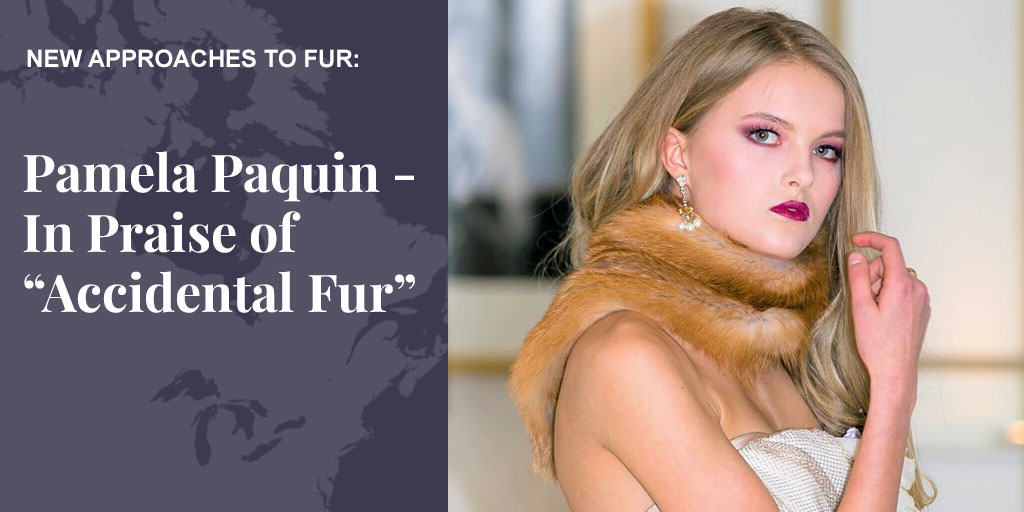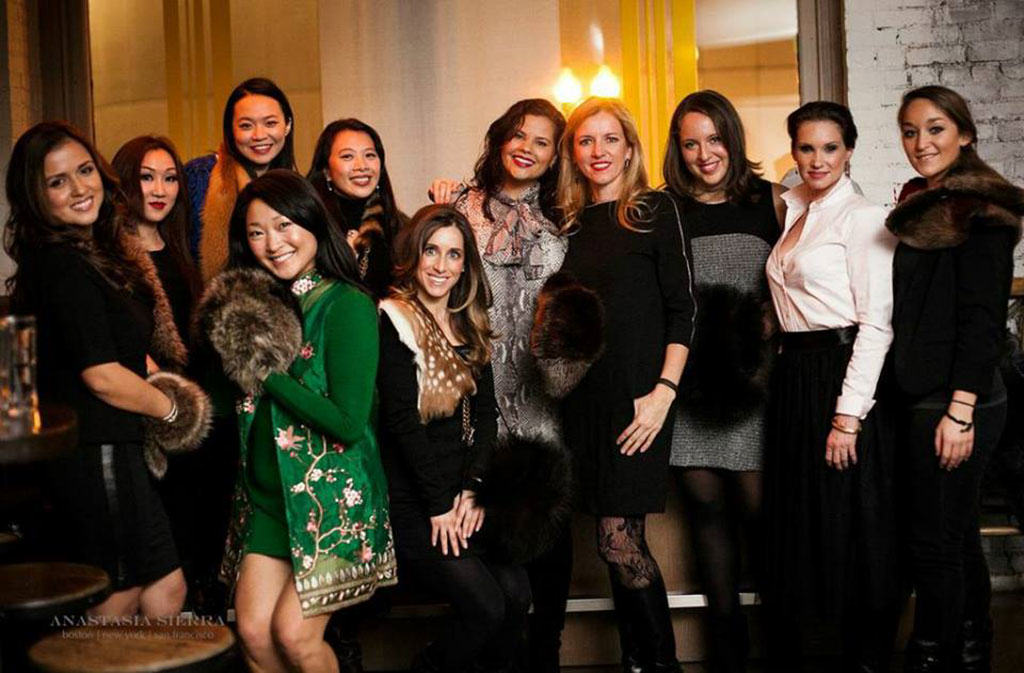Pamela Paquin – In Praise of “Accidental Fur”
by Alan Herscovici, Senior Researcher, Truth About FurThe strength of the fur industry is that it is always reinventing itself. In the 1970s and 1980s, it was…
Read More

The strength of the fur industry is that it is always reinventing itself. In the 1970s and 1980s, it was the revival of wild fur. In the 1990s, furs were sheared low and treated like fabric. Since the dawn of the 21st century, a new generation of designers is mixing it up, exploring a wide range of techniques and some very new approaches to marketing fur.
At TruthAboutFur, we enjoy introducing our readers to innovative creators like Brenda Dragon, who draws on her childhood on the land to make practical accessories for her growing Aurora Heat brand. Or New Zealand designer Jane Avery, who uses fur from culled rabbits to craft one-of-a-kind works of wearable art. Today we visit with American creator Pamela Paquin, a passionate promoter of “accidental fur”. What is accidental fur, you ask? Read on!

TaF: Pamela Paquin, you have specialized in a quite unusual sector of the fur trade. Tell us about “accidental fur”.
PP: As anyone who drives through the countryside knows, a very large number of furbearing animals are killed on our roads: raccoons, foxes, squirrels and many others. I recuperate these animals to make beautiful fur accessories that sell for anywhere from $45 to $2,000. I find that “accidental fur” is a more respectful term for these animals than “road kill”; I like to focus on their potential rather than how they ended up coming to me.
TaF: Did you come from a fur family?
PP: Not really, we were farmers. My father’s family were French-Canadian dairy farmers who came to Massachusetts from Quebec early in the 20th century; I am now living on a small piece of my great-grandfather’s farm. My mother was brought up in Greenwich, CT, 30 minutes from New York City. This mixed background gave me a sense of duality and engendered a respect for diversity and different ways of life. From childhood I wanted to make a difference in the world. I studied International Relations at Boston College and then worked in organizational management at MIT. Pursuing a Master’s in Peace Studies in Europe for a change of perspective, I then married a Dane; it was in Denmark that I first became aware of mink farming, which caught my attention because I had two pet ferrets at the time.

TaF: Is that when you became interested in working with fur?
PP: It wasn’t that simple. I was a vegetarian in Europe -- my response to growing awareness of the need to control our consumption of resources, and my desire to reduce violence in the world. I also thought that wearing synthetics was the way to be gentle with the planet – until a Danish furrier (Jane Eberlein of Samarkand) made me re-think my position on oil-based fabric including faux fur. I also came to understand that vegetarianism is not really natural for humans. And that fur is the result of 200 million years of R&D by nature to produce the ultimate way to keep a body warm and dry.
TaF: So did you begin to question your vegetarianism?
PP: Eco-systems sciences made me realize that cows and other herbivores recycle plants that humans can’t digest, but herbivores also need predators to maintain a balance. Humans are omnivores, and we have a role to play. It’s fine to be a vegetarian, but hypocrisy is rife in many ways: cats are carnivores, so to keep a cat you elevate your love for your cat above the lives of the animals that provide its food. Industrial soy production is destroying habitat. We’re all compromised, but I believe we should be as respectful as we can to the animals that feed and clothe us, and work together to bring compassion to sourcing from nature. Even my view of peace has evolved; I realize now that peace isn't a final goal or end-state, it’s a skill set to learn: we can only strive to manage conflict with compassion and consideration.
TaF: So how did you begin working with fur?
PP: When I came back to the States, I was trying to change careers and travel less while raising my daughter. I was struck by how many animals I saw by the side of the road -- you don’t see so many in Europe – and it got me thinking: here was a wonderful natural resource that was being wasted.
A local taxidermist named Tom White – The Rustic Moose – taught me how to skin and flesh. He helped me buy my tools and explained how the auctions and prices and the industry worked. I was also incredibly inspired by Mark Miller, in Boston, who continues to produce in the US; I give them a lot of credit for that! Moyle Mink & Tannery and USA Foxx & Furs have both been super kind and helpful regarding tanning - and attending the ILOE fur show was an inspiration regarding technique, Zuki in particular. I'm heartened that sheared beaver looks so much like mink, given how few wild mink, and how many beaver, I find.
I began making fur accessories for friends and neighbors, and people loved them. Suddenly the local media picked up my story, and next thing I was on Nightline, and even the BBC came knocking. I was not ready and it was quite a shock! I set up my website and that’s how I now sell most of my creations.

TaF: Your company is Peace Fur, and you have sometimes been quoted calling your products “ethical fur”. What do you think about mainstream trapping and fur farming?
PP: I consider myself to be part of the North American fur industry, full stop. Calling my products ethical – which could suggest others were not -- was as self-defeating as when we first named our company Petite Mort Fur, a play on words with the French euphemism for the female state after love-making! As a farmer who eats meat I have no problem with hunting or trapping when it's done with compassion.
Trappers have been on the front lines of conservation and the rebound of furbearers in North America. Trapping is also critical for controlling overpopulation, or invasive species like nutria in Louisiana, or possum and rabbit in New Zealand.
SEE ALSO: Abundant furbearers: An environmental success story.
I also respect farmers who work hard to provide their animals with excellent care; I eat meat and participate on our local agricultural council to ensure my food is compassionate. I know that farm-raising mink is a way to produce consistent, high-quality fur at a reasonable cost, while providing a range of natural colours, which means less dyeing.
From an animal-welfare perspective, it’s important that farmed mink can be humanely euthanized on the farm; they don’t have to be transported to distant slaughterhouses. Nonetheless, many potential clients aren’t comfortable with the idea of raising animals in cages; for these people, accidental fur provides another option. At least half of our customers have never worn fur before.
As a Peace Professional, I know better than to criticize other people’s choices. Some people prefer wild fur, some prefer farm-raised – and now Peace Fur provides a third option that can open new markets for the industry. I think there’s lots of growth potential here and I'm eager to share what I've learned. It's a big country and I can't pick up every raccoon, fox and coyote!

TaF: So do you think that others could be following your example?
PP: Absolutely! There are a growing number of us already and I've had designers reach out for wholesale. It is estimated that as many as one million animals are killed on our roads every day. That’s more than 360 million animals each year. I think it’s reasonable to suppose that, say, 50 million of those animals may provide quality fur. That’s a good portion of total world fur production today.
I believe accidental fur can attract a whole new generation of fur lovers, because it makes so much environmental and ethical sense to not waste this wonderful material.
TaF: So do you see opportunities for growth in the North American fur trade?
PP: I do, because our society is beginning to understand that fur is a natural and biodegradable material. Synthetics are not. We are choking the world with plastics, and we have to change. Our challenge as an industry is to show that we are not only sustainable, but also compassionate and respectful of the animals we work with. Certainly, with Millennials having more pets than babies, it's a perspective we should be aware of. People feel fur and think of the animal now, so showing respect in sourcing helps them feel proud of their furs.
Attracting new customers will also help to raise prices – which is important, because no industry can be sustainable if producers cannot make a living. Now that I understand how much work is involved in producing a fur pelt, it frustrates me they can be sold for so little. I believe that Peace Fur can help to increase understanding and appreciation for fur and the fur industry.
And maybe there's a bit of destiny at play, because there is a rich fur heritage in my family name: The House of Paquin was a fashion design and marketing powerhouse in Paris, in the late 19th and early 20th centuries. Jeanne Paquin was a courageous innovator and the first major female couturier. I like to think that I am also an innovator who can help the North American fur industry grow and thrive for the next century. The fur is already quite literally at our feet.
SEE ALSO: Roadkill salvage: When to hold 'em and when to fold 'em. By Furbearer Conservation.
***
To learn more about donating to Truth About Fur, click here.







